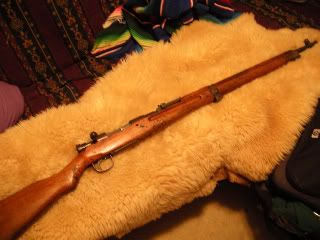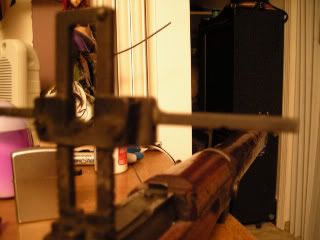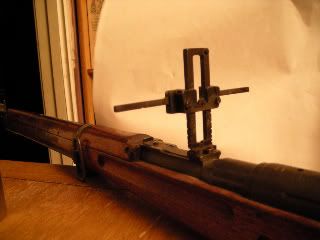Several years ago, I was at a small local gunshow, and saw the subject of today's post. It was sitting there, forlorn, on a table with a BUNCH of other rifles (who were all getting MUCH more attention). I recognized the safety, and asked about the rifle.

It's a Japanese Type 99 rifle. Shamelessly stolen bit:
The Japanese Arisaka Type 99 Rifle, manufactured 1939 to 1945 in the Tokyo and Nagoya Arsenals, Japan. It was the replacement of the Type 38 rifle and was the primary Japanese battle rifle until their surrender to Allied forces in 1945. The Type 99 is a variation of the Mauser design and early production models have probably one of the strongest receiver/action of any military bolt action rifles.
At the end of WWII the chrysanthemum (mum) markings on the receivers of surrendered Japanese rifles were removed. The sixteen petal mum is the imperial symbol of the Japanese Emperor. Below is an example of one that escaped being defaced.
http://www.radix.net/~bbrown/japanese_markings.html
Both the Long and Short Rifles were fitted with a sliding bolt cover (which traveled in narrow grooves cut in either side of the receiver as the bolt was worked) and a folding wire monopod pinned into a T-shaped block on the lower band. The monopod and bolt cover were usually dispensed with in battle. Later versions of the Type 99 may be unsafe to shoot as the quality of the metallurgy began to decline sharply after 1942. The later (1943-45) rifles are often identified as having a fixed notch rear sight instead of the customary folding/sliding leaf sight, no provision for attaching a sliding bolt cover or monopod or mounting an under barrel cleaning rod and the lack of a chrome-plated bore. Check with a qualified gunsmith if unsure.
The Japanese ideographs on the rifle receiver ring below the chrysanthemum in the photo translate as "99 Type." Many of chrysanthemum markings were ground off the rifles by surrendering Japanese troops because it was considered a disgrace to hand over a rifle was considered the property of the Emperor. An unconfirmed tale has it that General Douglas MacArthur at war's end also ordered the chrysanthemum markings removed from scores of captured Japanese rifles as part of the process of de-deifying the Emperor. (contributed by Michael E. Kreca)
This particular piece, while being earlier production, is (sadly) missing monopod, bolt cover, and bayonet (all of which I WILL be replacing). Still, the price was good ($100 out the door)...
Here's two shots of the "anti aircraft sights". Notice the notch on the arm: yes, you could lead the plane you were shooting at by different amounts. Not that I've heard of many US planes being shot down by one of these...


Interesting little sidelight: you can (apparently) create 7.7 Jap brass out of 30.06. Which is a good thing, as 7.7 Jap ammo is NOT cheap (running around $37/20 currently).
Haven't taken it out much, although she's fairly smooth. Being a Mauser design, that seems to be expected. Hit fairly close to point of aim. Once I pick up dies (NOT a high priority currently), she'll be getting much more of a workout...
-------------------------------------------------------------------------------
That's it for this week's look into the armslocker aboard the Privateer. Next week, I'll TRY and get Spoon to go cowboy for y'all...
No comments:
Post a Comment